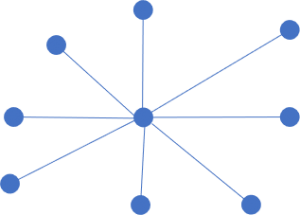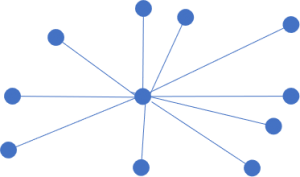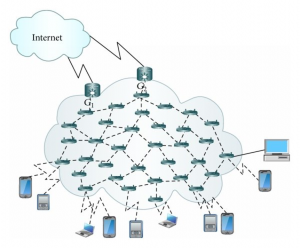Point to Multi-Point Network Topology
Topology refers to exactly how devices or nodes in a network are arranged. These topologies range from the very simple point to point, to various types of point to multipoint, to the more complex and harder to control multi point to multipoint topology sometimes referred to as mesh.
Point to multipoint networks are just what they sound like: One central node or hub communicates with several, up to hundreds in some cases, or end nodes. This is often also referred to as a star topology.
Star topologies are ideal for networks where there are a lot of nodes to be connected in a dense environment.
- The MAC or media sharing mechanism is quite a bit more complicated as one channel is shared amongst all the nodes connected to a central access point.
- Guaranteeing jitter and latency control is also a challenge, one which is typically solved by implementing centralize control for accessing the network in the access point or central node.
- Latency is almost always higher than that of a ptp network, sometimes by orders of magnitude going from micro secs to milliseconds.
- These networks are usually less efficient as well as more of the raw data rate is used by the more complex MAC layer.

With all of this one wonders why in the world would I ever use a PMP topology? The answer is simple – cost. If we take a hypothetical network connecting 10 customers to the internet, the ptp and ptmp diagrams below show how this might look.


It is clear from this example that installation of the ptp network will be much more expensive. At a minimum 20 nodes are being installed virus 11 in the PMP topology. Not only are there fewer boxes to be installed, decreasing deployment costs, and CAPex costs, but the PMP nodes themselves are significantly cheaper. This comes about a most PMP networks are based on high powered modems with all the RF and MAC functionality built in and are sold for a few dollars each. Management of the PMP network is also simplified. Fewer boxes, and I the PMP topology the central node or Base station unit controls the network hence the bulk of configuration is done once for the BU which controls al the customer nodes.
MP-MP
Multipoint to multipoint networks, or mesh, are the most complex topologies used in networking.

As one can easily see each node can communicate with multiple other nodes. Challenges with this type of network are mainly centered around the complexity of the MAC protocol, and guaranteeing jitter, latency budgets as well as controlling the data rate each end node receives. In addition, the deeper or more dense this network becomes (sometimes referred to as how many “Hops” from an end node to the Internet connection), latency will increase dramatically.
The benefits from such a network topology are focused around deployment and resiliency. Because any node can talk to any node, extending the network is very straightforward. As long as the new node can see any of the network, it has complete connectivity from anywhere to the Internet. These systems are designed to turn on, search for a neighboring node, and connect with minimal to no user configuration.
In addition, because most nodes have more than one path to reach the internet connection point, disruption in the network from a failed node or other impairment is automatically re-routed around the failure. This is done in real time ensuring that connectivity is maintained.
Conclusion
Topology choices for communications networks range from the simple to the complex. Each has its pros and cons and the network chosen is almost always driven by the application requirements. Choosing the right network deployment is a mix of performance requirements, cost, and complexity in designing installing and managing the system. Of course when we start to mix and connect the various topologies things can get even more complex. For every application the end goals must be clearly understood, and proper design tools available to ensure a successful network. Only with proper up front planning can one ensure the network does what it needs to do – connecting devices.


 by
by 

